Sit Back and Watch the Sunrise on a Grateful Universe
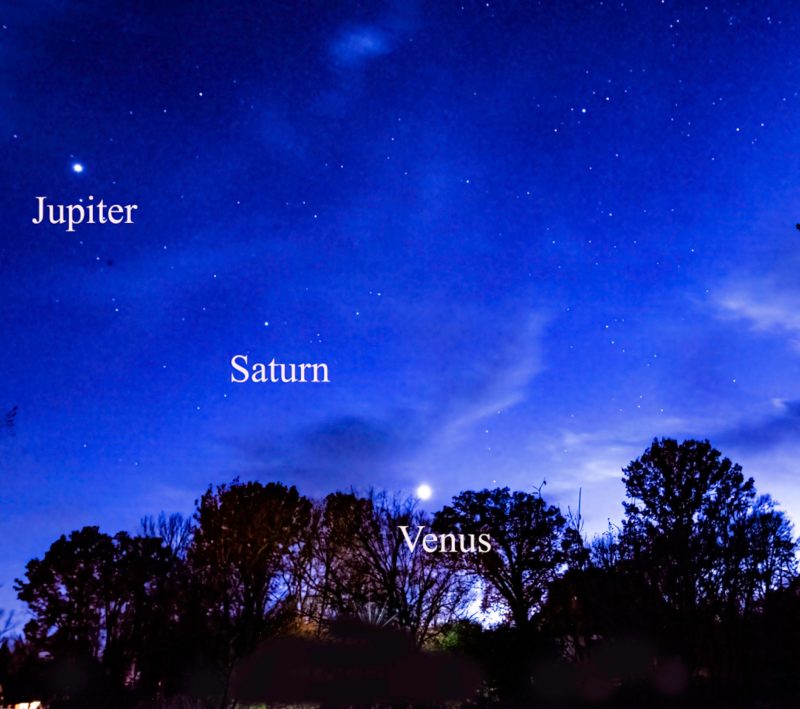
Find these visible planets in December 2021:
Venus
Jupiter
Saturn
Mercury
Mars
Plus:
Visible planets, stars, the moon and more
Total solar eclipse December 4
Geminid meteor shower
December full moon
Solstice on December 21
Ursid meteor shower
Heliocentric solar system December 2021
Late November and December 2021 planets in depth
EarthSky's 2022 lunar calendars are available now! We're guaranteed to sell out, so get one while you can. Makes a great gift!
Visible planets, stars, the moon and more
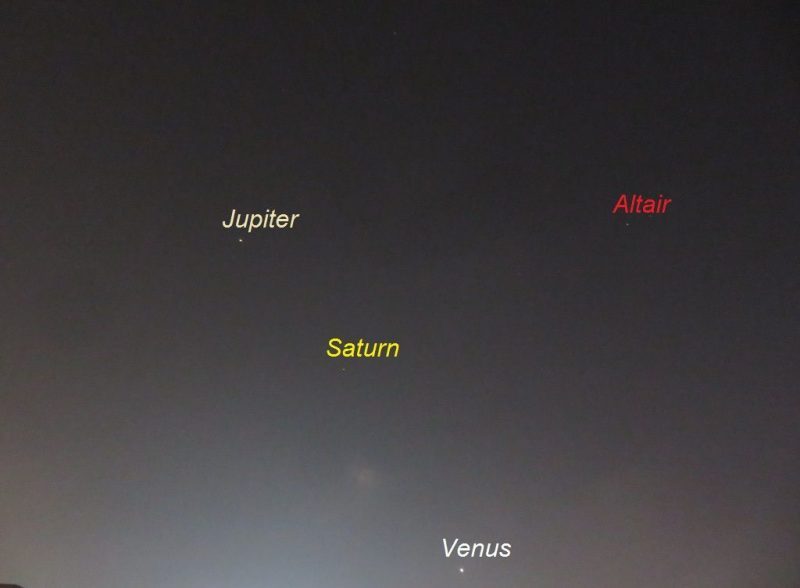


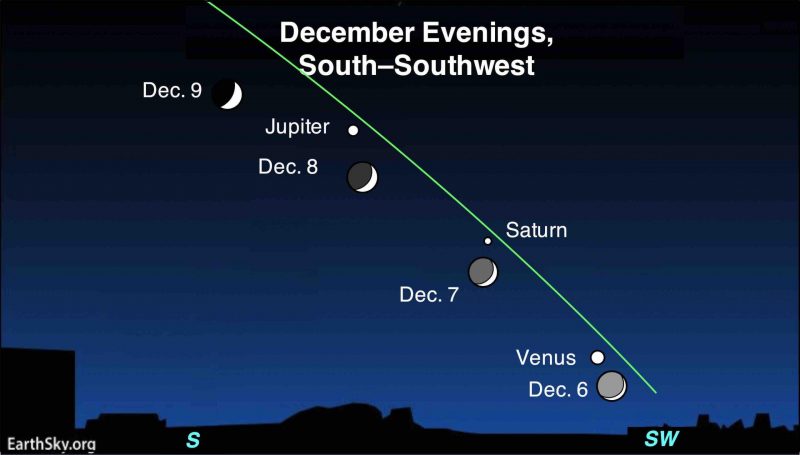

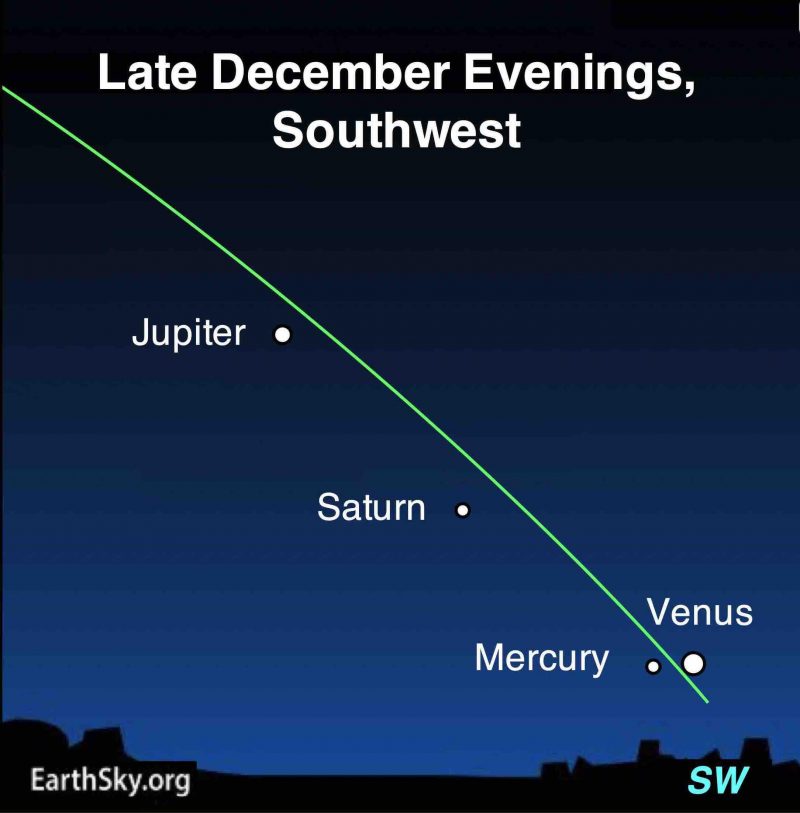
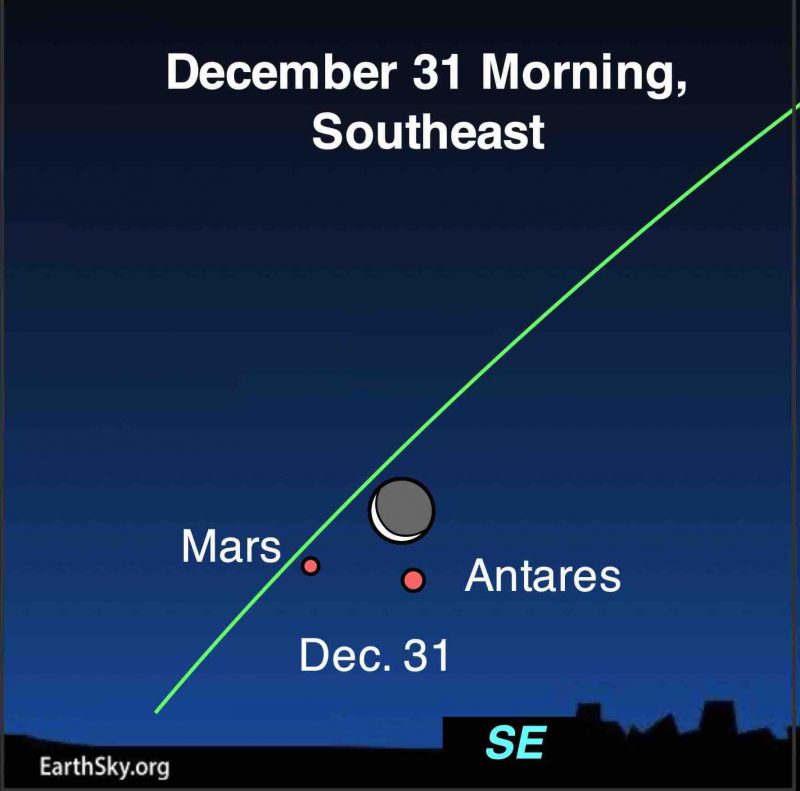

Total solar eclipse on December 4
A total solar eclipse sweeps across Antarctica on December 4, 2021 (during the night of December 3 for North America). People located at the southernmost tips of South America, Africa, Australia and New Zealand will experience the partial phases. The path of the moon's umbral shadow begins in the Southern Ocean about 300 miles (500 km) southeast of the Falkland Islands, crosses the Antarctic continent, and ends at sunset in the Southern Ocean. A partial eclipse will be seen within the much broader path of the moon's penumbral shadow, which includes the Southern Ocean, southern Africa and the southeastern corner of Australia and Tasmania. Read more about the total solar eclipse.
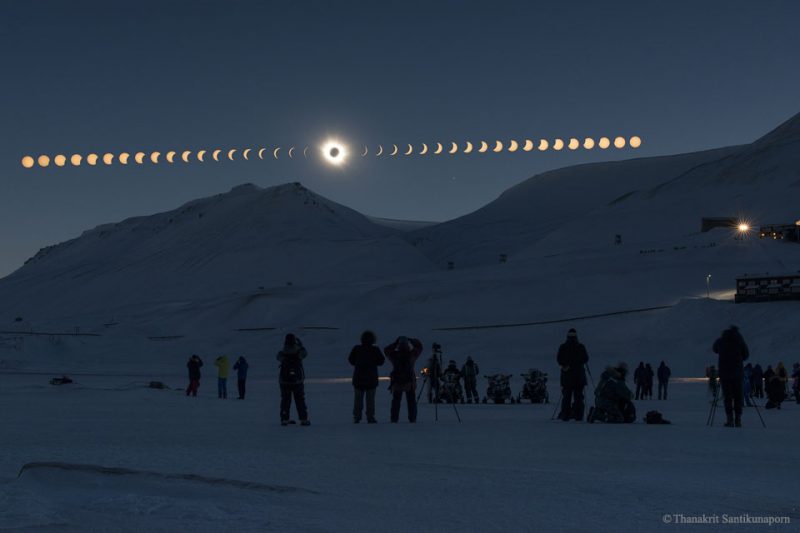
Geminid meteor shower morning of December 14
The Geminid meteor shower – always a favorite among the annual meteor showers – is expected to peak in 2021 on the night of Monday, December 13 into Tuesday, December 14. The Geminids are a reliable shower for those who watch around 2 a.m. from a dark-sky location. That's 2 a.m. local time, the time on your clock no matter where you are on the globe. We also often hear from those who see Geminid meteors in the late evening hours. This year, a waxing gibbous moon will be above the horizon during peak time for viewing. But it'll set shortly afterwards, leaving the sky dark for watching meteors. So the best time to watch for Geminid meteors in 2021 is likely before dawn – say, from around 3 a.m. to dawn – on the morning of December 14. Read more about 2021's Geminid meteor shower.
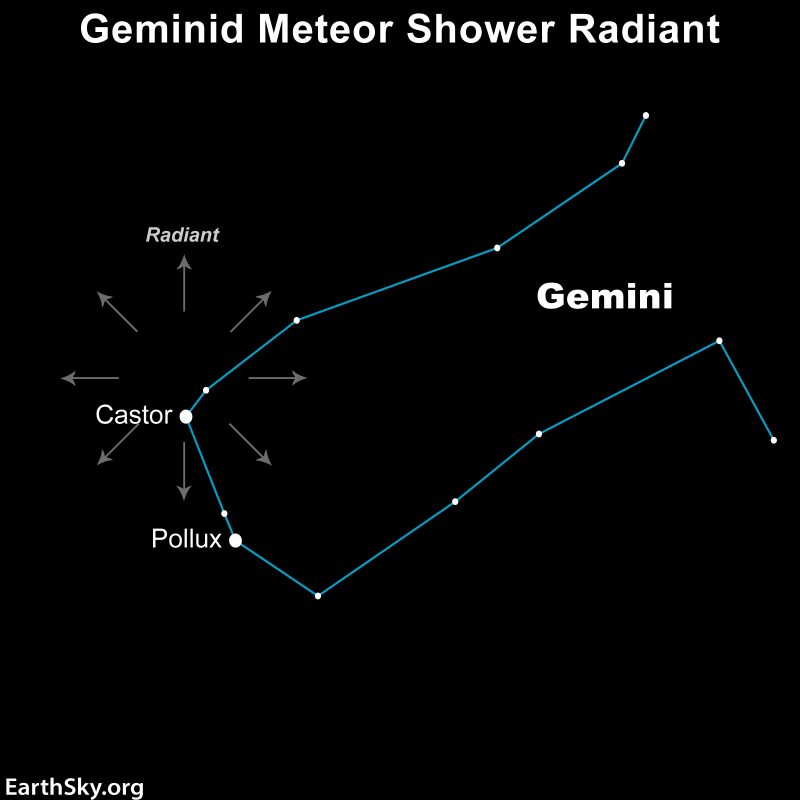
Full moon on December 18-19
Full moon is December 19 at 04:35 UTC (December 18, 11:35 p.m. Central Standard Time). This is the last full moon of the Northern Hemisphere's autumn – and Southern Hemisphere's springtime – and it's also the last full moon of 2021. Plus it's also the closest full moon to the December solstice.
This full moon happens one day after the moon reaches the farthest point in its orbit around Earth, called apogee. At apogee in December, the moon is 252,000 miles (400,000 km) away. That's about 12,000 miles (19,000 km) farther than the average moon-distance from Earth. As a result, on the night of full moon – December 18-19, 2021 – the moon is measurably smaller in our sky than usual. Your eye probably won't notice any difference, although the moon may appear less bright than you remember it at other months this past year. Many skywatchers are familiar with the term supermoon. That's a particularly large and bright full moon, near perigee, or its closest point to Earth. December's full moon is the opposite of a supermoon. We might call it a mini-moon or micromoon.
And here's something you can watch for with the December full moon. From the Northern Hemisphere, the moon's journey these next few nights will resemble the high path of the summer solstice sun. Read more about the December full moon.
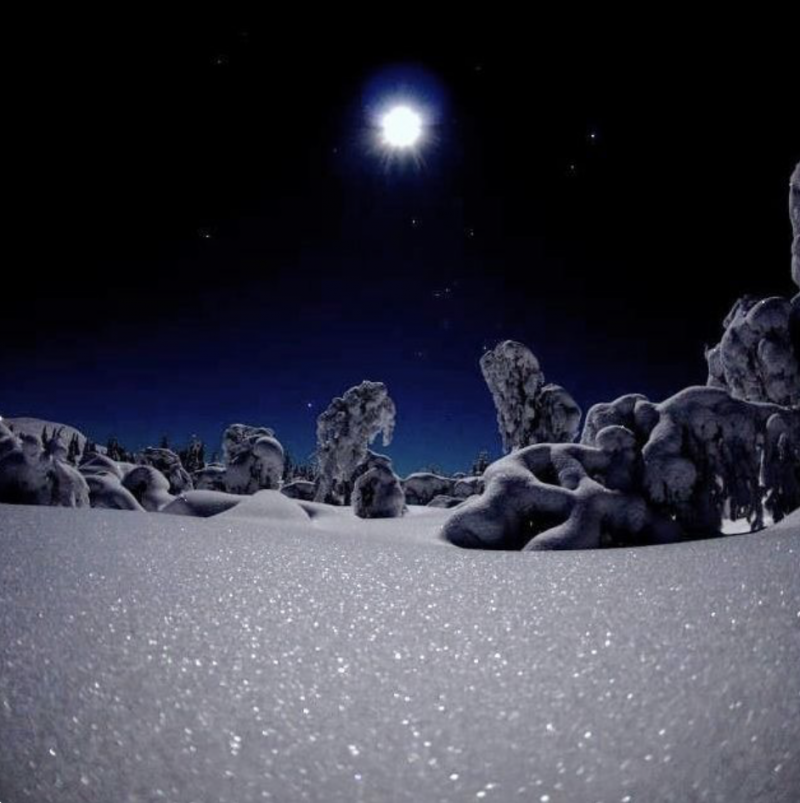
Solstice on December 21
The 2021 December solstice moment – when the sun reaches its southernmost point in the sky – happens on December 21 at 15:59 UTC (9:59 a.m. CST; translate UTC to your time).
At this solstice, the sun reaches its most southerly point on the sky's dome for the year. And so, at this solstice, the Northern Hemisphere has its shortest day and longest night of the year. The Southern Hemisphere has its longest day and shortest night.
No matter where you live on Earth's globe – no matter what time the solstice happens for you – it's a day to celebrate! It's a milestone in Earth's orbit and a marker of seasonal change. Read more about the December solstice.

Ursid meteor shower around the solstice
The annual Ursid meteor shower runs from about December 17 to 26 every year. It always peaks around the December solstice, which, in 2021, comes on December 21. The Ursids' peak is probably the morning of December 22, but any of the next few mornings should yield some Ursid meteors as well. Plus the Geminids are still going on, and should also run until around December 22. Read more about the Ursid meteor shower.

Heliocentric solar system December 2021
The chart below comes from Guy Ottewell. You'll find charts like these for every month of 2022 in his Astronomical Calendar.
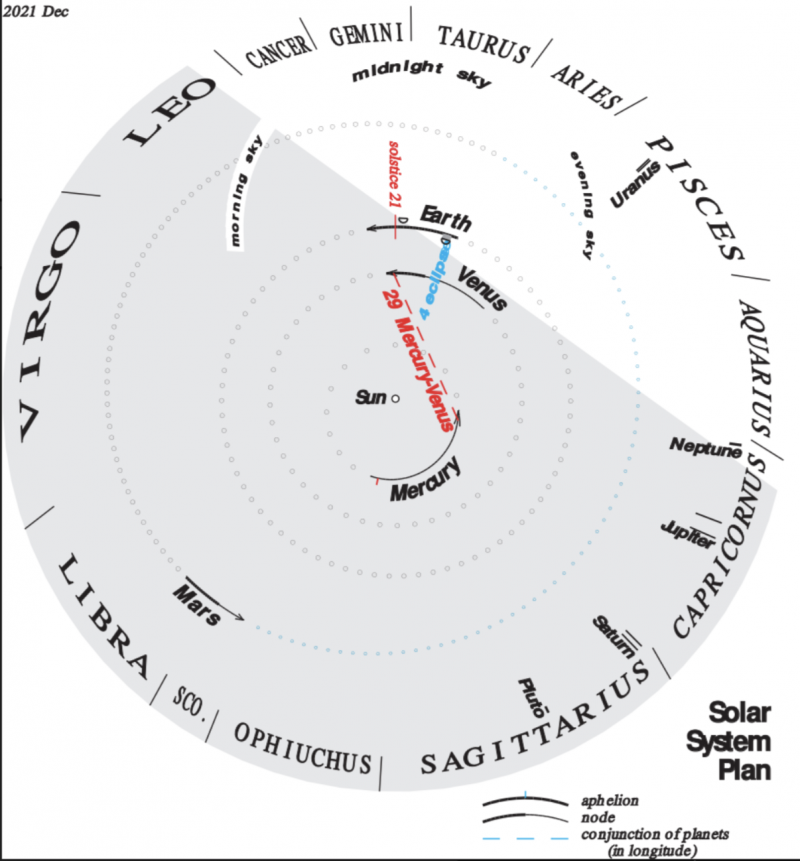
December 2021 planets in depth
Also see the indispensable Observer's Handbook, from the Royal Astronomical Society of Canada
Venus slides sunward throughout December 2021, dropping closer to the sunset point as western twilight darkens each day. The planet is easy to spot at the beginning of the month as the blazing starlike object near the sunset point. But Venus proves more difficult to spot near month's end as it gets closer to the sunset, appears in brighter twilight, and sets sooner behind the sun. Venus is about to move between the Earth and sun in its smaller, faster orbit. It'll be nearest the Earth-sun line – at inferior conjunction – on January 9, 2022.
On December 3, Venus will reach its greatest illuminated extent. That's when the lighted portion of the planet visible from Earth – the crescent Venus, seen through telescopes now – covers its greatest area on our sky's dome. And it's around this time that astronomers say Venus appears at greatest brilliancy.
As the month progresses, the lighted portion of Venus facing Earth will grow in size as the distance between our two worlds decreases. But we'll see less and less of Venus' lighted half, or day side. In other words, as the overall size of the crescent grows larger, the crescent itself will wane in phase. And that makes December 2021 the best time to view Venus with common household binoculars (or a telescope). Place binoculars on a steady support such as a tripod (you also hold them, and brace your elbows on a fence rail or your knees). Then sharply focus them. The planet will show itself as a tiny, thin crescent with the tips (or horns) of the crescent pointing away from the sunset point. Tip: If the cloud-covered Venus is too bright through your binoculars – and if it dazzles your eyes – try wearing sunglasses. Yes, sunglasses!
On December 6, the thin crescent moon slides directly below Venus, and presents an enchanting scene 45 minutes after sunset. The moon, softly glowing with earthshine, shows mysterious markings on its night side.
Jupiter is the second-brightest starlike object in the December evening sky (only Venus appears as a brighter "star"). Jupiter is still near fainter Saturn in our sky, nearly a year after their late 2020 great conjunction.
From the Northern Hemisphere, if you stand facing Jupiter in the southeast, Saturn will the be the starlike object on the brighter planet's right side. Saturn will sit about midway between Jupiter and Venus as the month begins, forming planetary bookends. They'll be very noticeable if you look in the evening twilight sky, in the direction of the sunset. Throughout December, Jupiter, Saturn and Venus evenly position themselves like jewels on a celestial string. We astronomers call this imaginary string across our sky the ecliptic. It's really the flat plane of our solar system, the plane in which all the major planets – and, for the most part, their moons – travel around the sun.
On December 6, 7, 8 and 9, the moon scoots along that string, first passing Venus, then Saturn, then Jupiter. A fascinating sight!
Throughout December, all three planets are sliding together towards the setting sun. We mentioned above that Venus will pass between the sun and Earth on January 9, 2022. Jupiter and Saturn have big, huge orbits, much wider than Earth's. They can't go between us and the sun, but instead are aiming now toward the far side of the sun from Earth. And they'll still be around – briefly, not far from the sunset – when 2022 begins. Then both will drop into the sun's glare, with Saturn disappearing first. Saturn will reach its superior conjunction on February 4, 2022. Jupiter will reach its superior conjunction on March 5, 2022. Those are the dates when these worlds will be most directly behind the sun. Afterwards, both planets will return to the east before dawn to begin another cycle of visibility in our sky.
In 2022, Saturn will reach its opposition – when Earth passes between it and the sun – on August 14. Jupiter's opposition will come on September 26.
Mercury is nowhere to be found for most of December. During that time, it's moving around the far side of the blinding sun, as seen from Earth. But on the last several evenings of the year, Mercury's angular distance from the sun on our sky's dome should be great enough that'll we'll glimpse the planet, briefly, perhaps 30 minutes after sunset, in the sunset direction. You'll need a sky that's clear to the horizon in the sunset direction. And you'll need to know just where to look. One of the charts above shows Mercury in relationship to Venus, Saturn and Jupiter in the western twilight, as December ends.
In late December, as Mercury comes into view, Venus will be almost gone from view, heading into the sunset glare, about to pass between us and the sun on January 9. Venus is bright, though. So you'll spot it just above the western horizon. And, for those of us in the Northern Hemisphere, much-dimmer Mercury will lie to the left of Venus. You might not notice it at first. It'll be fainter than Venus. Binoculars will be a great help. If you spot both Venus and Mercury, just imagine, in one view you'll have seen the two closest planets to our sun!
For this event, Southern Hemisphere stargazers will have no better of a view than Northern Hemisphere observers. But hopefully we'll all snag Mercury, if we try.
Mars, too, has been traveling behind the sun from Earth. In Mars' case, it's been gone for several months. But late December 2021 is also the time to start following the red planet again as it heads toward its bright appearance in December 2022. Mars should be just visible, with difficulty, in the direction of sunrise, before the sun comes up, on the last day or so of 2021. The thin waning crescent moon aids in your discovery of Mars on the final morning of the year.
These early-morning sightings – so near the sun – can be tricky. If you look too early, Mars won't have risen yet. If you look too late, bright twilight will drown Mars from view. So we advise you to start watching for Mars several days prior to December 31. Look toward the sunrise direction as twilight is beginning to light the sky. The pretty crescent moon, full with earthshine, will be above the horizon, near Mars, on December 31.
Directly below Mars, you'll likely see a red object. Don't be fooled! That is not Mars, but Antares, the brightest star in Scorpius. Because of its red tint, it's sometimes mistaken for Mars, the red planet. In fact, the name Antares stems from ancient Greek roots meaning "rival to Ares." Ares was the Greek name for the Roman Mars, the god of war. Antares got this name because its reddish color can be similar to that of Mars. And sometimes Mars can outshine Antares! But not so in late 2021. Mars – just returning from its sojourn behind the sun as seen from Earth – is at its faintest from our perspective now. It shines at about magnitude +1.5. Antares is slightly brighter at about magnitude +1.
On December 31, the moon, Antares, and Mars ring in the new year by forming an intriguing celestial triangle. This trio is best seen in binoculars. Southern Hemisphere viewers will see this event at a different angle than Northern Hemisphere viewers. From the southern part of Earth's globe, Mars will lie closer to the horizon than Antares, while the moon will hang just to the left of Antares. No matter. The trio will still be close and a sight to see as the year ends. See the charts above.
Some resources to enjoy
Don't miss anything. Subscribe to daily emails from EarthSky. It's free!
Visit EarthSky's Best Places to Stargaze to find a dark-sky location near you.
Post your planet photos at EarthSky Community Photos.
Visit Stellarium-Web or TheSkyLive for precise views from your location
The Old Farmer's Almanac provides specific planet rise and set info (U.S. and Canada)
Timeanddate.com provides specific planet rise and set info (worldwide)
Click here for recommended almanacs to find out precise rise and set times
Translate Universal Time (UTC) to your time
Read: Ecliptic is the sun's path in our sky
Read: Planet-observing is easy. Top tips here
Check out the indispensable Observer's Handbook, from the Royal Astronomical Society of Canada
Back by popular demand! Guy Ottewell's Astronomical Calendar for 2022
Great resource and beautiful wall chart: Guy Ottewell's zodiac wavy chart

Which ones are the visible planets?
In their outward order from the sun, the five bright planets are Mercury, Venus, Mars, Jupiter and Saturn. These are the planets easily visible without an optical aid. They're the planets watched by our ancestors since time immemorial. These planets do appear bright in our sky. They are typically as bright as – or brighter than – the brightest stars. Plus, these relatively nearby worlds tend to shine with a steadier light than the distant, twinkling stars.
You can spot them, and come to know them as faithful friends, if you try.

Bottom line: All you need to know about finding bright planets, stars and more in December 2021.
Help EarthSky keep going! Donate now.
Sit Back and Watch the Sunrise on a Grateful Universe
Source: https://earthsky.org/astronomy-essentials/visible-planets-tonight-mars-jupiter-venus-saturn-mercury/
0 Response to "Sit Back and Watch the Sunrise on a Grateful Universe"
Post a Comment